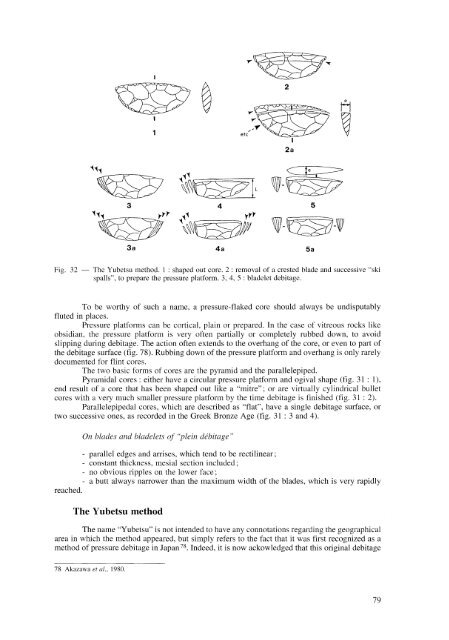Technology and Terminology of Knapped Stone - IRIT
Technology and Terminology of Knapped Stone - IRIT
Technology and Terminology of Knapped Stone - IRIT
Create successful ePaper yourself
Turn your PDF publications into a flip-book with our unique Google optimized e-Paper software.
3a 4 a 5 a<br />
Fig. 32 — The Yubetsu method. 1 : shaped out core. 2 : removal <strong>of</strong> a crested blade <strong>and</strong> successive "ski<br />
spalls", to prepare the pressure platform. 3, 4, 5 : bladelet debitage.<br />
To be worthy <strong>of</strong> such a name, a pressure-flaked core should always be undisputably<br />
fluted in places.<br />
Pressure platforms can be cortical, plain or prepared. In the case <strong>of</strong> vitreous rocks like<br />
obsidian, the pressure platform is very <strong>of</strong>ten partially or completely rubbed down, to avoid<br />
slipping during debitage. The action <strong>of</strong>ten extends to the overhang <strong>of</strong> the core, or even to part <strong>of</strong><br />
the debitage surface (fig. 78). Rubbing down <strong>of</strong> the pressure platform <strong>and</strong> overhang is only rarely<br />
documented for flint cores.<br />
The two basic forms <strong>of</strong> cores are the pyramid <strong>and</strong> the parallelepiped.<br />
Pyramidal cores : either have a circular pressure platform <strong>and</strong> ogival shape (fig. 31:1),<br />
end result <strong>of</strong> a core that has been shaped out like a "mitre"; or are virtually cylindrical bullet<br />
cores with a very much smaller pressure platform by the time debitage is finished (fig. 31:2).<br />
Parallelepipedal cores, which are described as "flat", have a single debitage surface, or<br />
two successive ones, as recorded in the Greek Bronze Age (fig. 31:3 <strong>and</strong> 4).<br />
On blades <strong>and</strong> bladelets <strong>of</strong> "plein debitage "<br />
- parallel edges <strong>and</strong> arrises, which tend to be rectilinear;<br />
- constant thickness, mesial section included;<br />
- no obvious ripples on the lower face;<br />
- a butt always narrower than the maximum width <strong>of</strong> the blades, which is very rapidly<br />
reached.<br />
The Yubetsu metho d<br />
The name "Yubetsu" is not intended to have any connotations regarding the geographical<br />
area in which the method appeared, but simply refers to the fact that it was first recognized as a<br />
method <strong>of</strong> pressure debitage in Japan 78<br />
. Indeed, it is now ackowledged that this original debitage<br />
78 Akazawa et aL, 1980.<br />
79

















